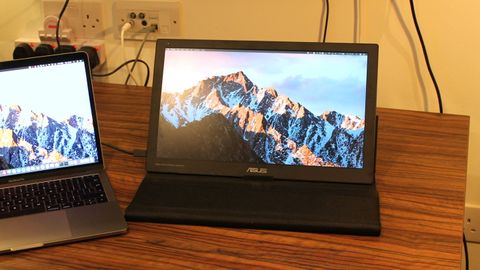TechRadar Verdict
A vital companion for productivity types on the move, the Asus MB169C+ is a convenient and practical portable monitor that banishes many of the flaws of its predecessors.
Pros
- +
Single USB-C cable for power and display
- +
Lag-free operation
- +
Good color saturation
- +
Impressive viewing angles
Cons
- -
A little on the dim side
- -
Carrying case is fiddly to use
- -
Kills your laptop's battery
Why you can trust TechRadar
Having more than one monitor is a boon for productivity, and it's usually easy to get hold of a second panel if you're working from home or the office. On the move, however, you can't exactly chuck your favorite 4K-resolution stunner into a backpack. For that reason, mobile workers have long felt the paint of having to revert back to using a single display.
Portable monitors are one solution to the conundrum, but devices in its category so far have been dogged by issues such as high input latency, poor viewing angles and washed out displays. Asus is looking to change that with the MB169C+, which follows on from its previous portable monitor, the MB168B+.
The company's newest offering boasts a 15-inch Full HD (1,920 x 1080) display and uses the newer USB Type-C connectivity standard, rather than USB-A like the MB168B+ – and it's convenient to boot.
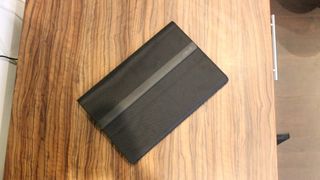
Portable package
Let's take a look at how the MB169C+ is put together. Even with the illustrated instruction manual to hand, it's not immediately clear how the monitor's case, which doubles up into a protective sleeve, folds into shape.
After a good 10 minutes of trial and error, we worked out that the back end of the case folds into a triangle and fastens tight via two velcro strips. At the other end, the flap folds over to the halfway point, which then allows you to tuck it underneath and balance the monitor on top.
The display can be inserted into one of three lips of material angled at varying degrees depending on what angle you want view the screen. It's a simple but effective method, and the display remains steadfast until you're ready to move it again.

Once in position, it's time to connect the USB-C cable to the port on the left-hand side of the monitor, with the other end going into your device of choice. We tested it using Apple's new 13-inch MacBook Pro, but the MB169C+ will work with any laptop equipped with a USB-C port that supports DisplayPort active mode.

An indicator light comes on the top-left hand side of the monitor to show that it's receiving a signal, and Asus' logo is displayed after around five seconds before the MacBook's extended picture pops up on the screen.
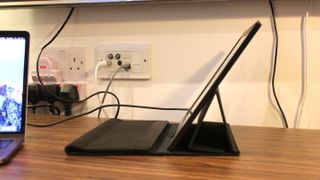
The MacBook Pro sports two USB 3.1 Gen 2 Thunderbolt 3 ports, delivering 10 Gbps of data transfer rates each. That's plenty for the MB169C+, which operates as smoothly as a regular external monitor. After using portable monitors with USB-A connections that suffer from high latency in the past, we found the MB169C+ refreshingly usable.
We even managed to play a few rounds of Overwatch on the MB169C+ using the MacBook in Boot Camp mode. The MB169C+ has a slick 5ms response time, meaning that it suffered from no ghosting trails during play.

Be aware that even when you're not gaming on it, the MB169C+ will bleed your laptop's battery life dry. That's not a fault of the Asus, but it is something that you'll have to bear in mind when taking your laptop and the MB169C+ to a coffee shop and working away from the mains for hours at a time.

Picture quality is good for a portable monitor, with deep blacks and relatively punchy colors. The image can be adjusted using a dial on the left-hand side, which combines with two rockers to allow for navigating the on-screen menu. From there you can select various color present modes – including Scenery, Standard, Theater, Game, Night View, sRGB, Reading and Darkroom - all with varying levels of brightness and color temperature.
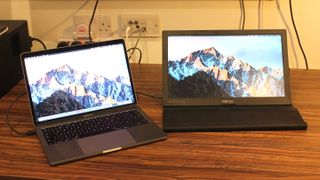
The first thing we did was crank up the brightness to maximum, as the picture on the screen felt a little too dim at anything lower. A degree of caution was needed from that point on, as tinkering too much with the contrast and other settings caused greys and lighter colors to become indistinguishable from whites as they blended into one another. Move the menu's sliders too high and websites like Reddit that use striped colors schemes become a pain to read, and easily picking out data on spreadsheets with alternate colored rows becomes similarly tough.

Because it uses an IPS panel, rather than TN like many older portable monitors, the MB169C+ boasts great viewing angles. They're easily good enough to watch movies on the screen sat with a friend, and it means you can position the monitor at a more extreme angle while you're working on your laptop.

Weighing just 800 grams, the MB169C+ is perfectly weighted for slinging into a backpack along with a laptop to take on the move. In fact, such was our experience with the MB169C+, that for people in need of more screen real-estate on the go, we would recommend combining it with a 13-inch laptop instead of choosing a 15-inch laptop from the outset. (Unless you absolutely require the greater processing power of a 15-inch laptop such as the quad-core MacBook Pro, for example.)
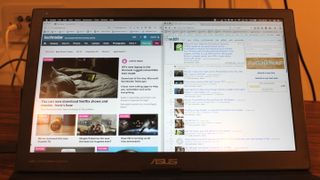
Final verdict
The Asus MB169C+ is undoubtedly one of the best portable monitors out there today. Requiring a single USB-C cable for video and power, it's high on convenience and low on problems, with none of the latency and viewing angle issues posed by older portable monitors rearing their head on this occasion.
On the negative side, even on maximum brightness you're not going to get a screen that's lit up as much as even cheaper laptops. Still, if you're not planning to use the MB169C+ outdoors, its impressive color saturation, lag-free operation and lightweight build all make it a winner for productive road warriors.
